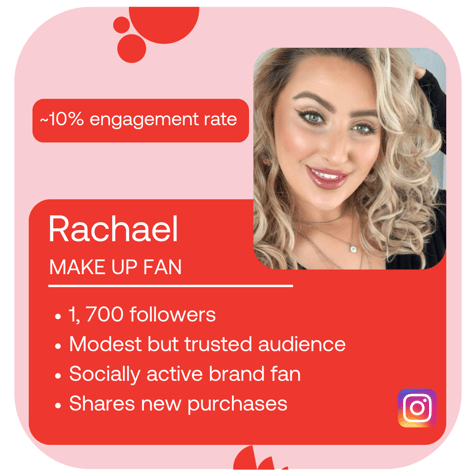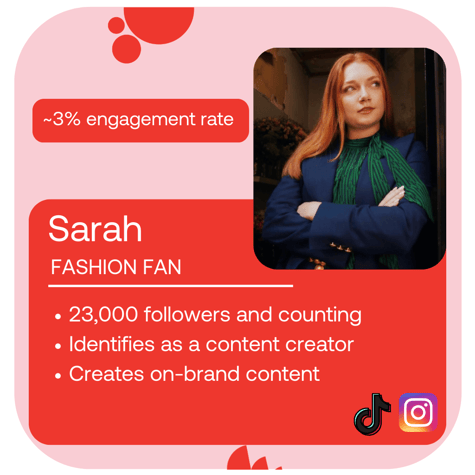Blog
Social Affiliates vs Brand Ambassadors: what's the difference?
‘Brand Ambassadors’ and ‘Social Affiliates’ are two different types of advocates a brand can activate, to drive awareness or revenue and thereby increase customer acquisition. They are both incredibly valuable, but their actions essentially fulfil distinct objectives.
For both types of brand advocates this article breaks down:
- Who they are & what they do for the brand
- What the result of their activity is
- How their activity is engineered
- Who is typically responsible for them at the brand
Who they are and what they do for the brand
Social Affiliates:
These are fans of your brand whose followers are genuine connections - including friends, family and colleagues.
They:
- Already love and advocate for your brand online
- Have a modest, but trusted audience (1K-5K)
- Are socially active and use these platforms to share new purchases with their audience
For a more in-depth breakdown on Social Affiliates, click here.

Brand Ambassadors:
These are authentic micro-influencers in your brand’s existing customer base, officially recognized by the brand as representatives.
They:
- Already love and advocate for your brand online
- Identify as content creators
- Are growing a significant following (5K-50K)
- Create on-brand, aspirational content to share with their audience
For a more in-depth breakdown on Brand Ambassadors, click here.

What the result of that activity is
Ambassadors and Social Affiliates both drive customer acquisition. The difference lies in how.
Social Affiliates:
Social Affiliates convert customers for you. As their networks are filled with people they know and connect with regularly, they garner a greater level of trust.
Studies reflect this, with 88% of consumers stating they are more likely to trust recommendations from people they know, and 90% of people stating they trust suggestions from family and friends in particular.
Social Affiliates in action - ELEMIS
The skincare brand sought to grow revenue through Social Affiliates rather than relying on advertising or traditional influencer strategies to drive customer acquisition.
From Nov 2022 - Sep 2023 ELEMIS has:
- Generated £261k in referral revenue
- Achieved 11x ROI
Read the full case study >
Brand Ambassadors:
Brand ambassadors have a greater scale of influence, and therefore social reach as a result. Creating brand awareness amongst their audiences is incredibly valuable for brands.
They achieve higher engagement rates than bigger influencers, especially on TikTok where the difference in active engagement between micro and macro-influencers is 18% to 5%, respectively.
Brand Ambassadors in action - Mint Velvet
This fashion brand engages its ambassadors and incentivizes them to create and share content on behalf of the brand with their own followers.
In 12 months alone, Mint Velvet has:- Achieved 8x ROI
- Reached an audience of 5m+
- Collected 1,892 pieces of authentic UGC by ambassadors.
Read the full case study >
As a result, both of these advocate types working together allows brands to turn their customers into their biggest acquisition channel.
Want to learn how you can mobilize the social affiliates and brand ambassadors in your own customer base?
How is their activity is engineered
Both Social Affiliates and Brand Ambassadors already love and shout about your brand online. Incentivizing them with rewards and brand perks helps generate more of this activity and drive results, like increasing product sales and generating reach in the millions.
An increasing number of brands now look to build programs for their Social Affiliates and Brand Ambassadors to incentivize this activity at scale. This enables them to track their advocates’ activity and engineer more of it.
Social Affiliates:
As they’re fans first and advocates second (or as a result), opportunities where they can be rewarded are like icing on the cake.
- Product gifting
- Store credit
- Commission opportunities
Brand Ambassadors:
As they love the brand, create great content and embody its values and lifestyle, opportunities for interaction (and more content creation) are perfect for these advocates.
- Early access to new product releases
- Spotlights on brand’s social media & campaign opportunities
- Exclusive access to brand events
Who is typically responsible for them at the brand
Social Affiliates:
Performance marketing, affiliate, acquisition and growth teams all measure their success by looking at metrics like revenue, product sales and ROI.
It is logical therefore that Social Affiliates fall under these teams’ remit at the brand, as they impact bottom-of-funnel metrics.
Their circle of influence consists of genuine connections - including friends, family and colleagues. This means that people trust their content, click on the affiliate link and make the purchase - ultimately leading to a higher conversion rate, and therefore an increase in product sales.
Brand Ambassadors:
PR, Social, Influencer Marketing and Brand Marketing teams all look to leverage storytelling opportunities with ambassadors to impact brand awareness metrics.
They want to:
- Increase brand recognition, measuring metrics such as reach, views and impressions
- Access on-brand UGC to leverage in social campaigns
- Tap into new audiences through their ambassadors’ networks
Ultimately, incorporating both Social Affiliates and Brand Ambassadors in your brand’s core growth strategy has potential to impact your bottom line. As it becomes increasingly difficult and expensive to acquire customers, finding alternative solutions is vital. Mobilizing brand fans that already love you to help achieve this could be just the answer you’re looking for.
Ready to mobilize the Social Affiliates and Brand Ambassadors in your own customer base?

%20%20(1).png?width=1800&height=500&name=S_A%20blog%20banner%20(revised)%20%20(1).png)

